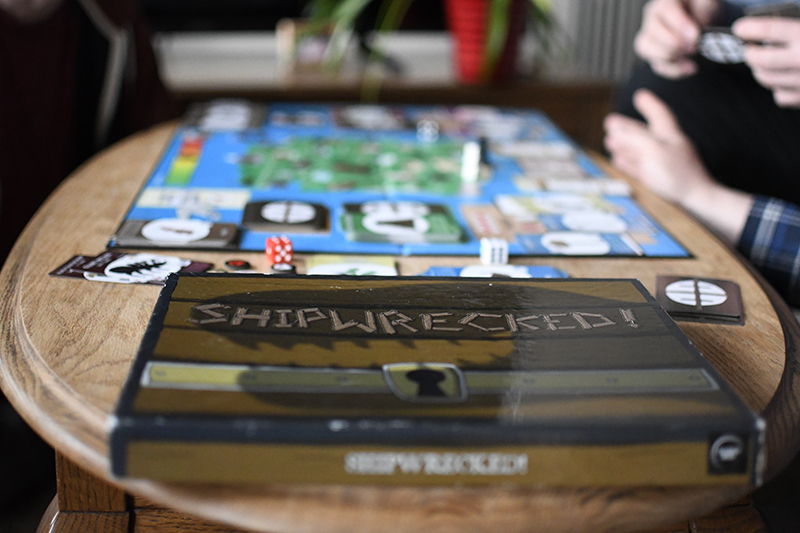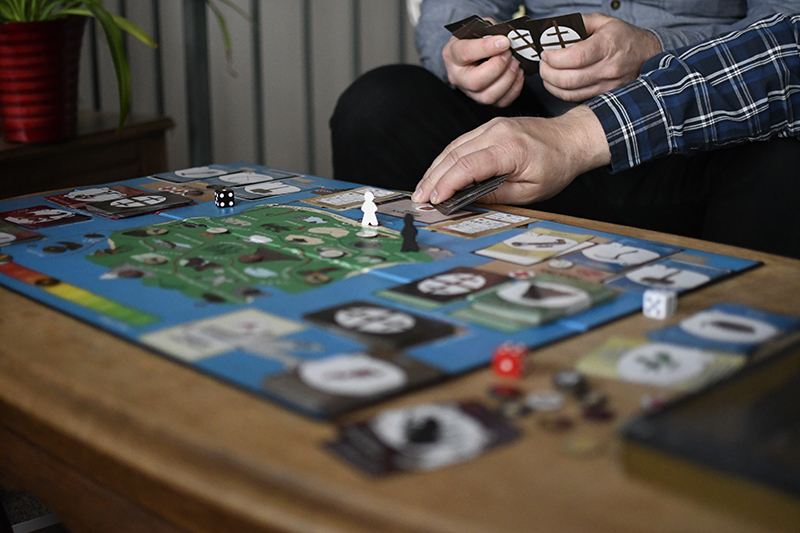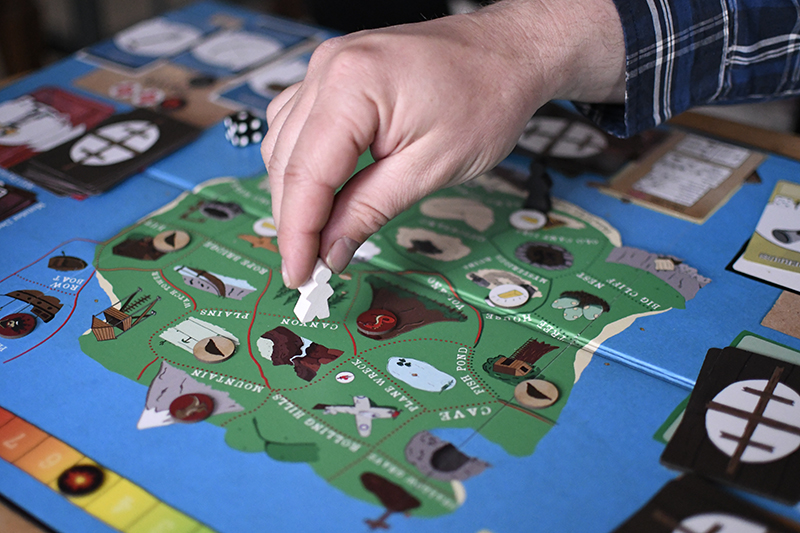All things considered, the folks stranded on Gilligan’s Island had it pretty easy. I mean, they didn’t have to contend with things like dinosaurs, pirates, and monsters…rather it was usually just one doofus screwing up rescue attempt after rescue attempt. “Shipwrecked!”, a tabletop game for 1-4 players and ages 12+ with an average play time of 1-1.5 hours, has all of those aforementioned things and more. It’s a semi-cooperative survival game where players strive to have the most riches and make it out alive. Special thanks to developer Matt Clarke for sending a copy for review purposes. I’m required by FTC regulations to disclose that I was paid to cover this game, but any and all opinions are my own. The only thing paid for here was my time.
My copy came with a main “Mysterious Island” board, 4 character mats, 4 character pieces, 4 crafting cards, 5 combat dice (D6s), 36 resource cards, 20 treasure cards, 10 reward cards, 20 craftables cards, 31 green zone cards, 31 red zone cards, and 32 various tokens to track different things.

Despite the component count, setting up the game was fairly easy. In summary, players choose either to be a brawn or brain character (minimum one each per game) and receive a character mat, player piece, crafting card, and combat die as well as choose an ability token. Players then seed the board with monster lair tokens, soil tokens, a volcano/eruption tracker token, and enemy hitpoints token in their appropriate locations. Red (red zone), green (green zone), and gold (treasure) decks are shuffled and placed on the board. The brown (resources) cards are sorted into resource piles by type and the rest of the decks are placed nearby without needing to be shuffled. Players start on the shipwreck location and the youngest brain player goes first.
The game itself is broken up into rounds. Each round consists of the player phase and the island phase, completed in that order.
Player Phase – Each player will get 4 action points to spend however they like. Each action costs 1 AP. These actions include moving, gathering, crafting, digging, eating, trading, brawling, fighting a monster, escaping, and waiting.
Island Phase – Each player draws a zone card (green or red) depending on where they are located on the board and resolve the card. These cards can be events, items, or enemies.
While I don’t want to rehash the rulebook, I do want to go over some of the actions so that you have an idea as to what a typical turn may involve.

Gathering, for example, is used to pick up raw materials or food from the resources deck. Materials can only be gathered in their respective appropriate locations…flint can be gathered where there are grey rocks for example. Gathering is useful because it helps players craft, an action used to create various items from the craftables deck. These include things like spears, torches, shovels, and so on. Brains characters have a different list of craftable items compared to brawn characters, so working together is necessary to perform different tasks. Players will often trade (another action) for what they need.
One of the craftable tools is a shovel, which is used to accomplish the dig action. This involves flipping the soil token at that location to determine if the player gets to draw a treasure card. Treasure maps, a type of item, are consumable to guarantee a treasure card. Players can brawl each other and/or fight monsters, both of which have slightly different rules. While both involve the rolling of dice and comparing values, brawls are typically more about stealing items from the other player and not about losing HP. As an aside, if you lose all three of your hitpoints you are knocked out (but not eliminated). KO’d players lose one item per turn until they either run out of cards (they are restored to full health afterwards) or another player rescues them. Food can help restore hitpoints but permanent injuries can never be restored.
Rounds continue until one of two things happen:
1. One or more players manage to escape the island. The winner is the player with the most treasure points.
2. The volcano erupts and everyone loses. Zone cards (drawn by players every round) will sometimes advance the volcano eruption token along the track, so don’t take too long!
Escaping the island (another action) won’t be easy. Players must, as a whole, defeat three monsters and have at least one of the four possible means of escape cards. Three escape cards are joint escape while the other is betrayal escape…the former simply means that both brains and brawn must be present at the specified location while the latter means only one player needs to be at the specified location. Players not involved in the escape get one final turn to try and save themselves. Successfully brawling with an escapee can lead to your victory, if you manage to reach them in time.
Note: The above doesn’t cover all of the rules found in the manual, but should give you an idea as to how the game is played.

The first thing I look for in any tabletop or digital game are variable difficulty modes and I’m pleased to report that there is both an easy and hard mode available. Easy mode allows players to eat during combat encounters AND makes the action free while hard mode tasks players with defeating all five monsters (instead of just three). There’s also a single player variant where a single player controls one brain and one brawn character and thus doesn’t have to worry about betrayal, but they will however need to defeat all five monsters and escape with fifty treasure points. House rules are encouraged and I’m all for that.
I like the idea of semi-cooperative games in that you’re encouraged to work with other players (but not fully). As a result, you never know if the other player is truly going to help you at any key moment in the game. This psychological battle of wits is what makes games like “Munchkin” and “Dead of Winter” so popular. I do recommend parental guidance if kids are playing just so that one player isn’t the constant target of brawls. I do appreciate the game’s crafting system and the whole idea that brawn characters have a separate crafting sheet than brains. This almost forces players to work together if they are looking to get specific things done. Not mentioned above is the brawn’s ability to carry brains around the map using the move action…very helpful indeed! Cooperation is also encouraged as monster hit points/attack power are fairly high, resulting in the need for team combat.
The game itself is fairly light and has that randomness to it like a lot of other casual games do. While the green zone deck is less dangerous than the red zone deck, you’re still at the mercy of whatever card you draw. You’re also still at the mercy of dice rolls in combat. When drawing treasure, there’s no guarantee you’ll draw a high value treasure compared to a low value treasure, or even a valuable treasure at all (some are items that can be used). As such, I’d consider this a game appropriate for those who like the “Robinson Crusoe” theme but with a much lighter approach. To be fair, some like that level of randomness.
My biggest gripe is the price. As you all know, I take price into consideration when reviewing a game because let’s face it, we’re all not made of money. The game’s retail price on the Game Crafter is currently $63.99, which is pretty high compared to other games out there that have more components and are of better quality. By the same token, The Game Crafter isn’t a bulk producer and therefore charges the creator more for each copy produced. The average consumer doesn’t typically care mind you, but it’s worth pointing out. That being said, the developer is planning a crowd sale in July, 2021 to help players get the game for a bit cheaper.
Along those same lines, I was disappointed by the component quality…the tokens were laser cut and I ended up with soot all over my hands. If any game is going to retail at $60+, there shouldn’t be soot on my hands…I think that’s a more of a dig at The Game Crafter though. I don’t want to discourage the use of The Game Crafter…they’ve helped plenty of people to realize their vision and make it a reality. I just wish they didn’t charge as much as they do.
The art was pretty good, but I would have made the red zone areas more pronounced…red spaces as opposed to green spaces with red outlines. I would have also changed the card backs to be different based on color/type for ease of sorting from the reverse side. I liked the variety of the cards…the developer clearly put a lot of thought into how they could all work together.
“Shipwrecked!” has an appealing theme and channels some cool ideas…it’s worth checking out if you have the dough available to buy it. Compared to other games on the market, the price is just too high for the component quality (and soot) that you’re getting here. Long story short: cool ideas, decent theme, way overpriced for what it is. Hopefully the developer manages to find a cheaper way to produce this game and therefore reduce the MSRP to a more appropriate and recommendable $25-$30.
Final Verdict: 5/10 (Average)
—
